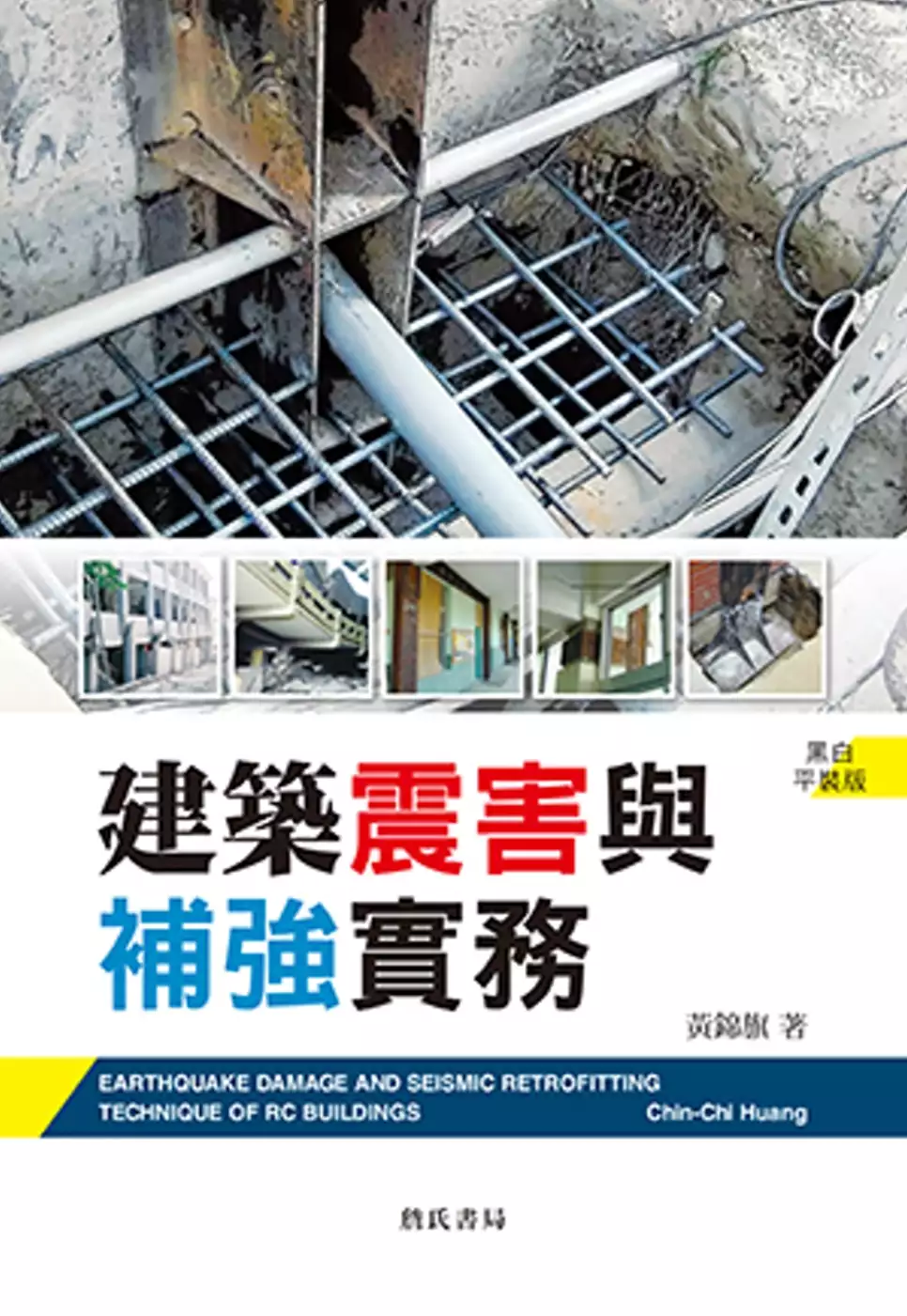206 RC 2004的問題,我們搜遍了碩博士論文和台灣出版的書籍,推薦黃錦旗寫的 建築震害與補強實務(二版) 可以從中找到所需的評價。
國立臺北科技大學 電資學院外國學生專班(iEECS) 白敦文所指導 VAIBHAV KUMAR SUNKARIA的 An Integrated Approach For Uncovering Novel DNA Methylation Biomarkers For Non-small Cell Lung Carcinoma (2022),提出206 RC 2004關鍵因素是什麼,來自於Lung Cancer、LUAD、LUSC、NSCLC、DNA methylation、Comorbidity Disease、Biomarkers、SCT、FOXD3、TRIM58、TAC1。
而第二篇論文國立臺灣科技大學 應用科技研究所 王志逢、賴君義所指導 Dula Daksa Ejeta的 無氟超疏水高分子複合材料製備及其在高效能油水分離與乳化液分離之應用 (2021),提出因為有 超疏水、超親油、聚(4-乙基苯酚)、聚氧代氮代苯并環己烷、熱固形高分子、油水分離、乳化液分離的重點而找出了 206 RC 2004的解答。
建築震害與補強實務(二版)

為了解決206 RC 2004 的問題,作者黃錦旗 這樣論述:
本書特色 地震速報真的來得及救你一命嗎? 建築物出現裂縫就代表結構脆弱? 軟弱底層與偏心扭轉振動的問題建物註定無可解救? 關於震害與結構補強的迷思,專家一次解答! 過去幾年來,鋼板補強工法已拯救50餘建築物免於震害之險 鋼板補強工法,是在原有的RC柱或RC樑及周邊增加鋼板,並利用化學錨栓及環氧樹脂與原有柱樑緊密結合,使用鋼板補強工法,最大優點是不會改變原有柱樑系統的結構行為,每邊柱樑僅會增加1-2公分寬,外觀改變甚小;而在建物現地推垮的實測中,與其它補強法相較,經鋼板補強後的校舍所能承受的最大基層剪力(耐震能力)最為優越。
An Integrated Approach For Uncovering Novel DNA Methylation Biomarkers For Non-small Cell Lung Carcinoma
為了解決206 RC 2004 的問題,作者VAIBHAV KUMAR SUNKARIA 這樣論述:
Introduction - Lung cancer is one of primal and ubiquitous cause of cancer related fatalities in the world. Leading cause of these fatalities is non-small cell lung cancer (NSCLC) with a proportion of 85%. The major subtypes of NSCLC are Lung Adenocarcinoma (LUAD) and Lung Small Cell Carcinoma (LUS
C). Early-stage surgical detection and removal of tumor offers a favorable prognosis and better survival rates. However, a major portion of 75% subjects have stage III/IV at the time of diagnosis and despite advanced major developments in oncology survival rates remain poor. Carcinogens produce wide
spread DNA methylation changes within cells. These changes are characterized by globally hyper or hypo methylated regions around CpG islands, many of these changes occur early in tumorigenesis and are highly prevalent across a tumor type.Structure - This research work took advantage of publicly avai
lable methylation profiling resources and relevant comorbidities for lung cancer patients extracted from meta-analysis of scientific review and journal available at PubMed and CNKI search which were combined systematically to explore effective DNA methylation markers for NSCLC. We also tried to iden
tify common CpG loci between Caucasian, Black and Asian racial groups for identifying ubiquitous candidate genes thoroughly. Statistical analysis and GO ontology were also conducted to explore associated novel biomarkers. These novel findings could facilitate design of accurate diagnostic panel for
practical clinical relevance.Methodology - DNA methylation profiles were extracted from TCGA for 418 LUAD and 370 LUSC tissue samples from patients compared with 32 and 42 non-malignant ones respectively. Standard pipeline was conducted to discover significant differentially methylated sites as prim
ary biomarkers. Secondary biomarkers were extracted by incorporating genes associated with comorbidities from meta-analysis of research articles. Concordant candidates were utilized for NSCLC relevant biomarker candidates. Gene ontology annotations were used to calculate gene-pair distance matrix fo
r all candidate biomarkers. Clustering algorithms were utilized to categorize candidate genes into different functional groups using the gene distance matrix. There were 35 CpG loci identified by comparing TCGA training cohort with GEO testing cohort from these functional groups, and 4 gene-based pa
nel was devised after finding highly discriminatory diagnostic panel through combinatorial validation of each functional cluster.Results – To evaluate the gene panel for NSCLC, the methylation levels of SCT(Secritin), FOXD3(Forkhead Box D3), TRIM58(Tripartite Motif Containing 58) and TAC1(Tachikinin
1) were tested. Individually each gene showed significant methylation difference between LUAD and LUSC training cohort. Combined 4-gene panel AUC, sensitivity/specificity were evaluated with 0.9596, 90.43%/100% in LUAD; 0.949, 86.95%/98.21% in LUSC TCGA training cohort; 0.94, 85.92%/97.37 in GEO 66
836; 0.91,89.17%/100% in GEO 83842 smokers; 0.948, 91.67%/100% in GEO83842 non-smokers independent testing cohort. Our study validates SCT, FOXD3, TRIM58 and TAC1 based gene panel has great potential in early recognition of NSCLC undetermined lung nodules. The findings can yield universally accurate
and robust markers facilitating early diagnosis and rapid severity examination.
無氟超疏水高分子複合材料製備及其在高效能油水分離與乳化液分離之應用
為了解決206 RC 2004 的問題,作者Dula Daksa Ejeta 這樣論述:
在工業上以及我們的日常生活中常會產生許多含油廢水,這些含油廢水的排放以及海面上的漏油汙染皆會對自然環境造成嚴重的影響。此外,在石油化學工業中,油品中的少量水分也會對其造成許多問題,這些問題需耗費許多資源來解決。因此,開發具有高通量、低耗能、操作簡易、低成本、可量產之乳化劑穩定油包水乳化液處理材料是一個重要的課題。在本研究分為三個部分,我們製備三種具有不含氟、價格低廉之超疏水高分子複合材料。第一個研究中,我們利用聚(4-乙基苯酚)與1,3-phenylene bisoxazoline改質市售棉花,製備具有超疏水與超親油特性之高分子複合材料。此材料經壓縮後可應用於油包水乳化液分離,在重力過濾與加
壓過濾下可分別展現10,400 L m-2 h-1 (gravity-driven) and 867,500 L m-2 h-1 bar-1 (0.1 bar)的高通量。在第二個研究中,我們以主練型聚氧代氮代苯并環己烷改質美耐皿海綿製備超疏水材料,此材料展現極佳的吸油特性(最多可吸附本身重量170倍之油汙),壓縮後可應用於油包水乳化液分離,在重力過濾與加壓過濾下可分別展現13,900 L m-2 h-1 (gravity-driven) and 1,353,000 L m-2 h-1 bar-1 (0.025 bar)的高通量。最後一個研究中,我們利用酚醛樹脂與氧代氮代苯并環己烷改質市售棉花,
製備超疏水高分子複合材料。此材料可應用於油水混和液分離,展現1.8x105 L m-2 h-1的高通量。壓縮後可應用於油包水乳化液分離,展現1.6x106 L m-2 h-1 bar-1 (0.025 bar)的高通量。以上的乳化液分離實驗中,濾液的油純度皆高於99.95 wt%,分離效果良好。我們的超疏水高分子複合材料因其高通量、高分離效率、低成本的製備方法皆說明它們在現實應用中具有巨大的潛力。